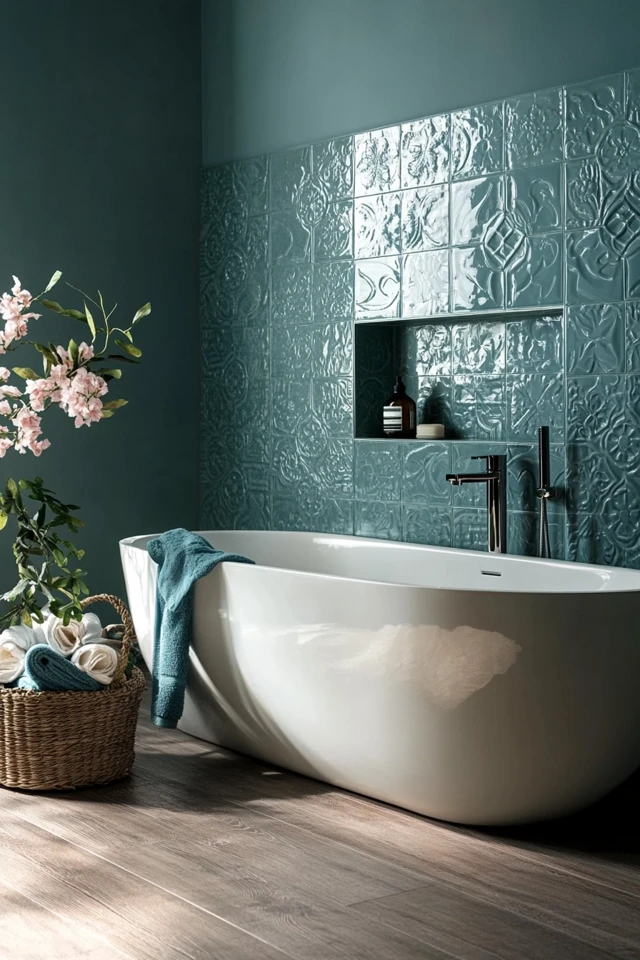When designing a coastal bathroom, tiles play a crucial role in setting the tone and aesthetic of the space. From ocean-inspired hues to natural textures that mimic sandy shores, the right tile choices can transform your bathroom into a serene seaside retreat. Coastal tile trends are all about creating a breezy, relaxed atmosphere while adding character and sophistication to your space.
I remember revamping my guest bathroom with a stunning blue mosaic tile backsplash. The moment it was installed, the room came alive—it felt like I had brought a slice of the ocean indoors. The shimmer of the tiles, combined with soft natural accents, created a space that was both elegant and inviting.
Whether you’re planning a full remodel or simply updating a small area, here are the top coastal bathroom tile trends to inspire your next project.
1. Sea Glass-Inspired Tiles
Why It Works
Sea glass tiles capture the translucent beauty of ocean treasures, adding a touch of shimmer and color to your bathroom.
How to Use It
- Create a backsplash behind the sink or shower for a subtle pop of color.
- Use mosaic patterns to add texture and visual interest.
- Pair with white or neutral walls to let the tiles shine.
Example:
A shower lined with aqua and teal sea glass tiles evokes the feeling of swimming in clear tropical waters.
2. Textured Sandstone Tiles
Why It Works
Sandstone tiles mimic the look and feel of natural sand, bringing a warm, earthy element to coastal bathrooms.
How to Use It
- Use large sandstone tiles for flooring to create a seamless, beach-like foundation.
- Incorporate textured sandstone in the shower or as an accent wall.
- Pair with driftwood or rattan accents for a cohesive, natural look.
Styling Tip:
Choose a light beige or cream-colored sandstone to keep the space feeling airy and bright.
Picture Gallery
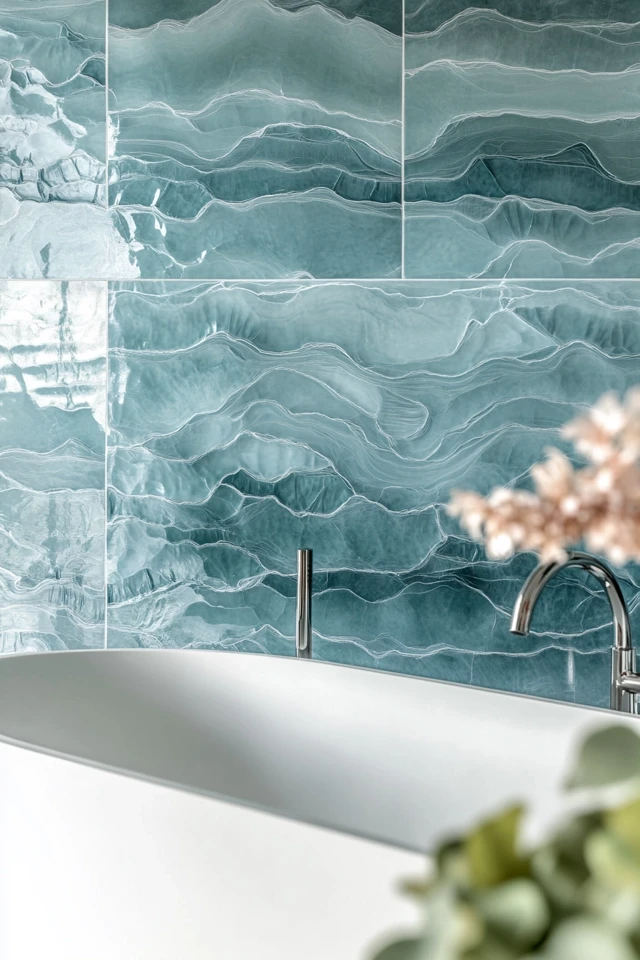

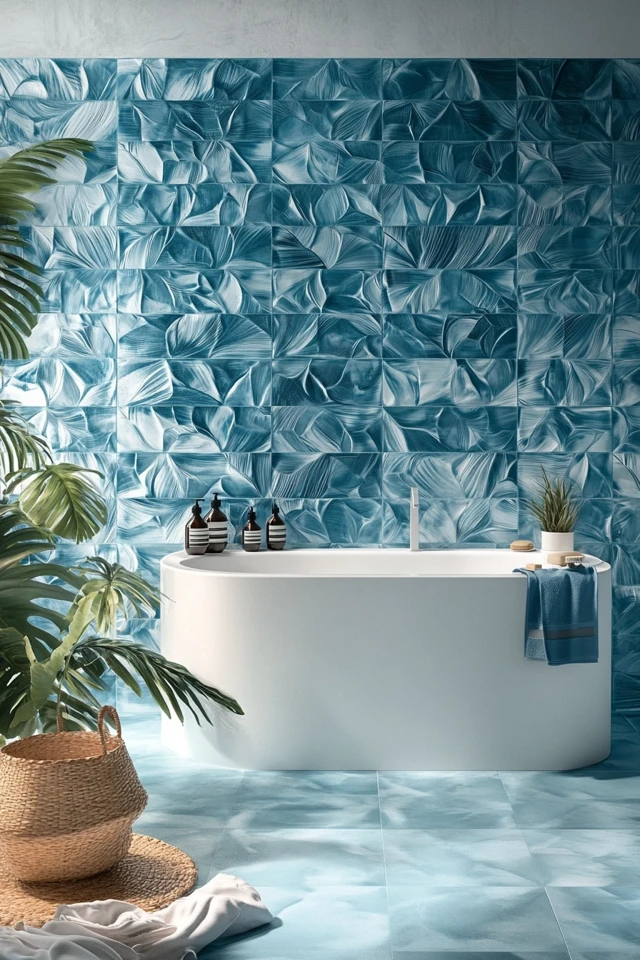
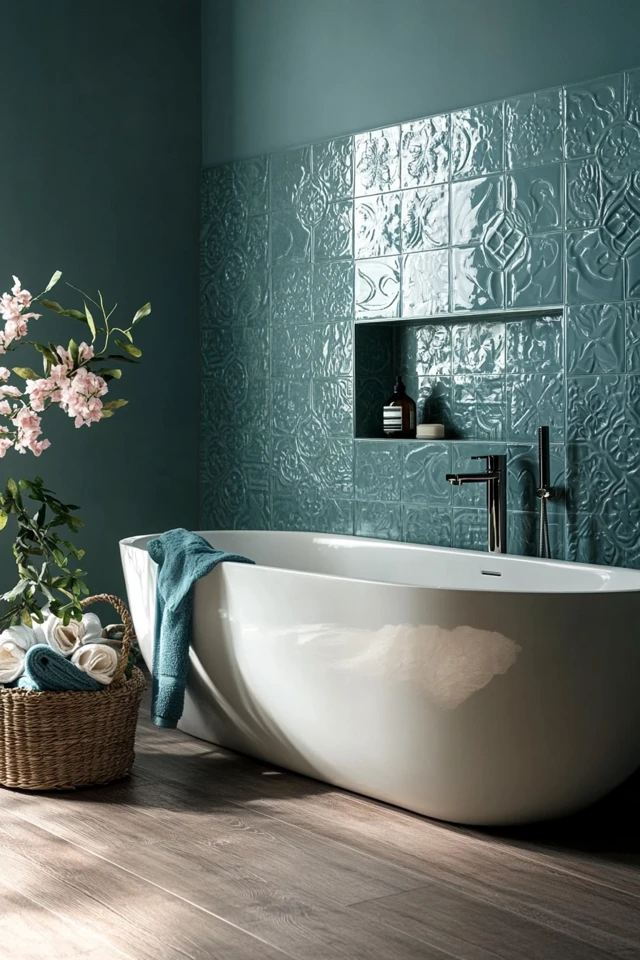
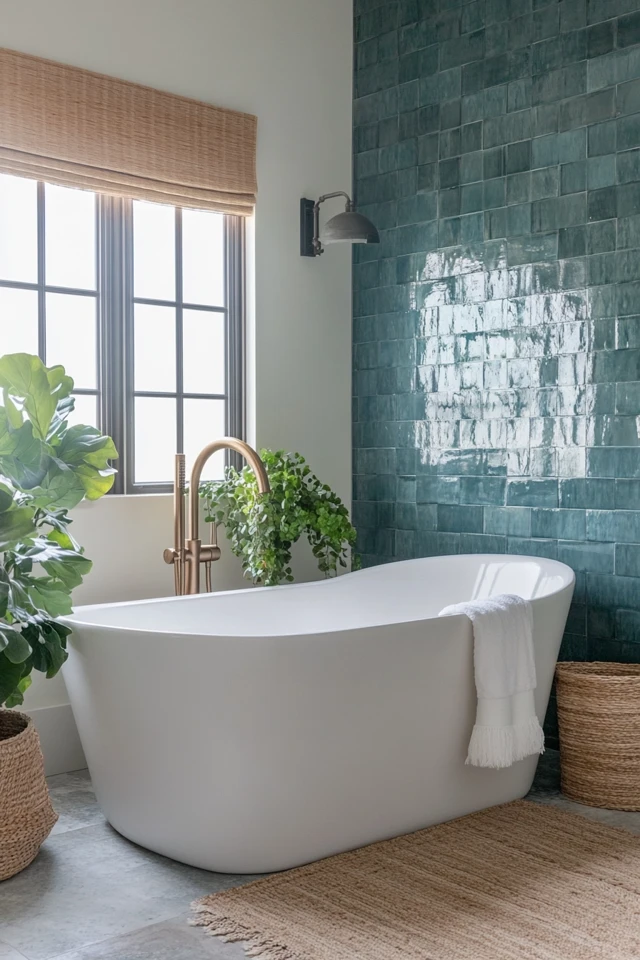
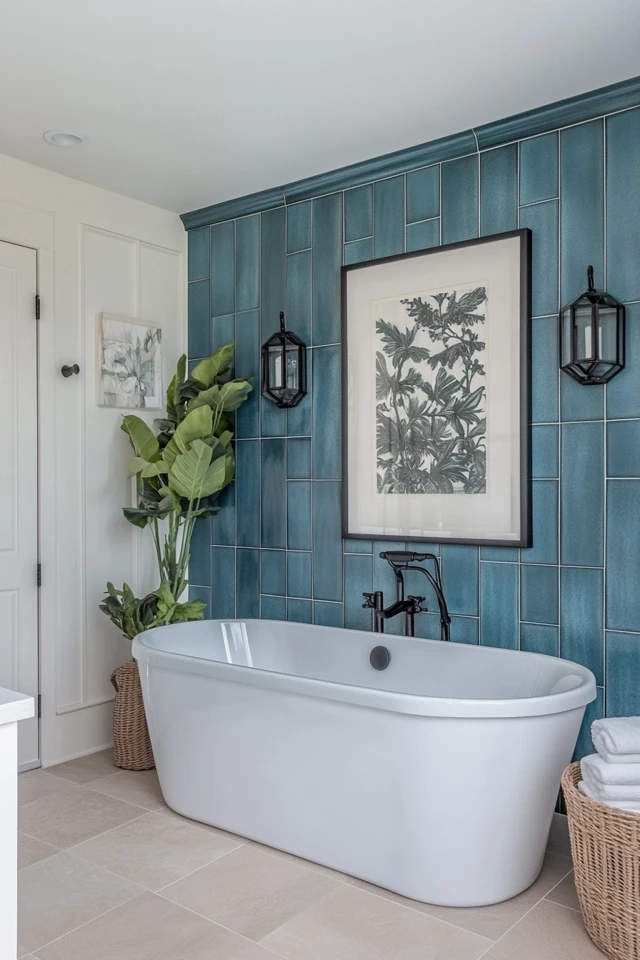
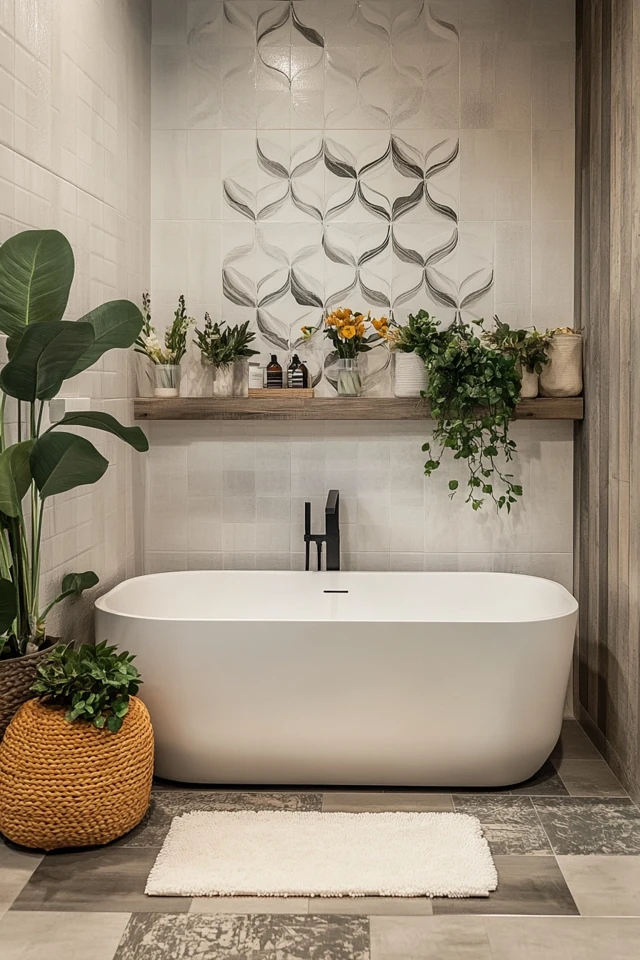
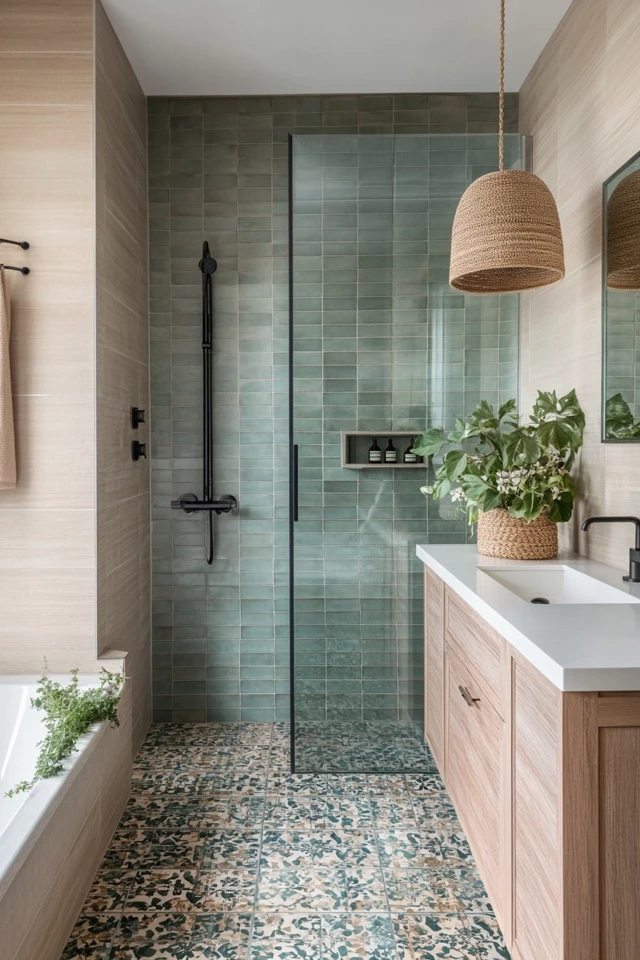
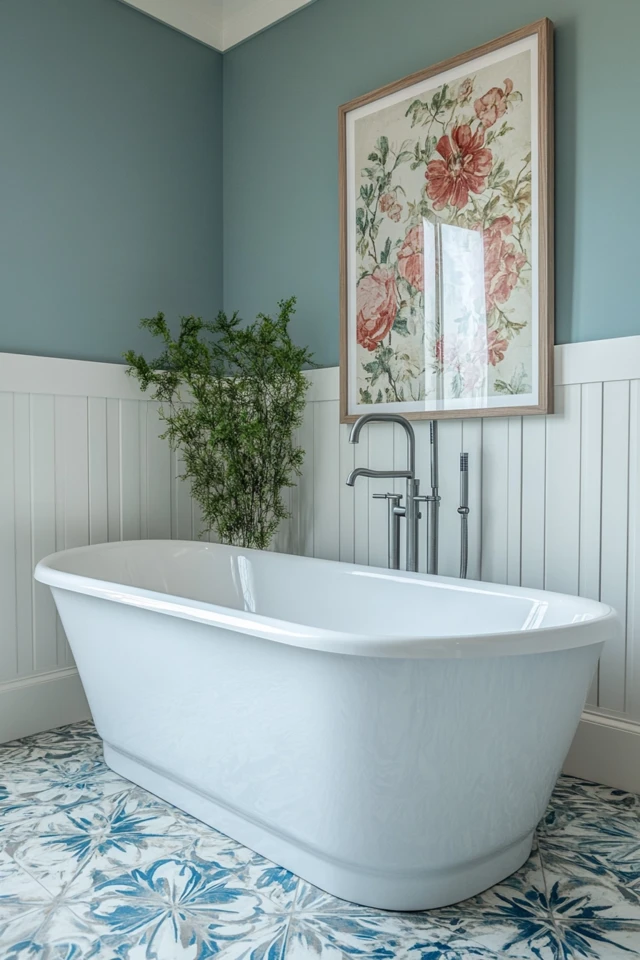
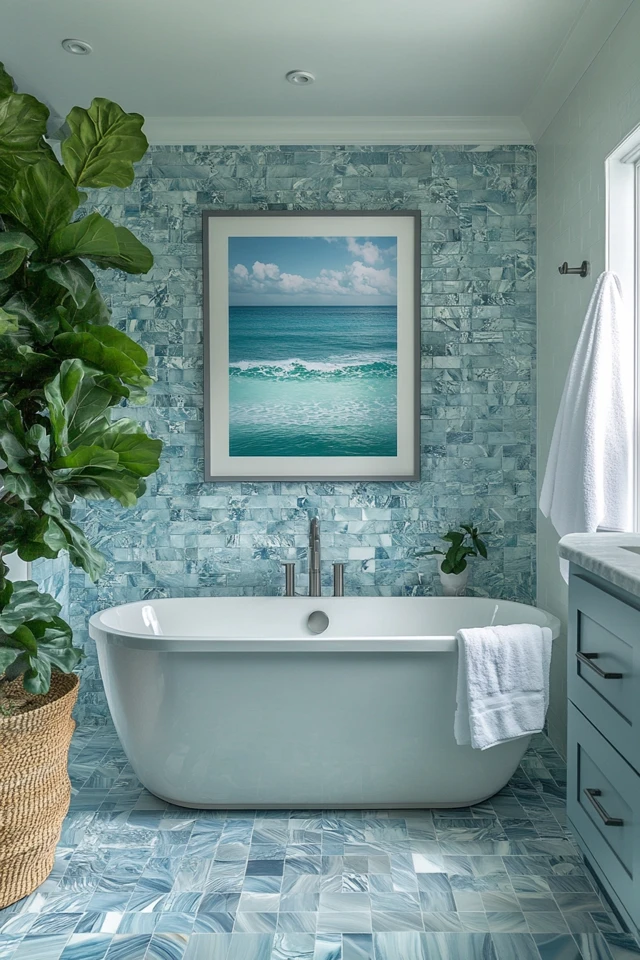


3. Bold Nautical Stripes
Why It Works
Striped tiles in classic navy and white instantly create a nautical vibe, perfect for a coastal-themed bathroom.
How to Use It
- Install horizontal or vertical stripes on one wall to make a bold statement.
- Use smaller striped tiles for a fun backsplash or shower niche.
- Balance the bold pattern with solid-colored tiles elsewhere in the room.
Example:
A striped navy and white tile wall behind the sink pairs beautifully with brass fixtures for a classic coastal look.
4. Iridescent Shell Tiles
Why It Works
Shell-inspired tiles with an iridescent finish reflect light beautifully, mimicking the shimmer of seashells in the sunlight.
How to Use It
- Use as an accent in the shower or around the vanity mirror.
- Create a feature wall with larger shell-patterned tiles.
- Pair with soft pastel hues for a dreamy, oceanic effect.
Styling Tip:
Iridescent tiles work best when paired with natural light to enhance their reflective quality.
5. Pebble Mosaic Flooring
Why It Works
Pebble tiles mimic the texture of a rocky shoreline, offering a natural, spa-like feel underfoot.
How to Use It
- Install pebble tiles in the shower floor for a massage-like texture.
- Use them as a border or inlay within larger tile patterns.
- Pair with neutral tiles to let the pebbles stand out.
Example:
A pebble mosaic shower floor paired with white subway tiles creates a modern coastal aesthetic.
6. Wavy Patterns
Why It Works
Wave-patterned tiles bring motion and a sense of calm to your bathroom, echoing the rhythm of the ocean.
How to Use It
- Use wave-patterned tiles as a backsplash or in the shower for a statement design.
- Pair with solid-colored tiles to avoid overwhelming the space.
- Opt for subtle wave patterns in soft blues or grays for a minimalist look.
Styling Tip:
Choose tiles with raised or embossed wave patterns for added texture and depth.
7. Wood-Look Porcelain Tiles
Why It Works
Porcelain tiles that mimic the look of driftwood add warmth and texture to a coastal bathroom while being durable and waterproof.
How to Use It
- Use wood-look tiles for flooring to create a beachy, natural base.
- Install them on the walls to mimic the look of shiplap.
- Pair with white or seafoam green tiles for a fresh, coastal palette.
Example:
Light gray driftwood-look tiles paired with sea glass accents create a modern beach house vibe.
8. Blue and White Moroccan Tiles
Why It Works
Moroccan-style tiles in blue and white bring an exotic, coastal touch to bathrooms, with intricate patterns reminiscent of Mediterranean seaside villas.
How to Use It
- Use as a statement floor or wall design for a bold look.
- Incorporate smaller sections, like shower niches or backsplashes, for a subtle touch.
- Pair with clean, modern fixtures to balance the ornate patterns.
Example:
A blue-and-white Moroccan tile floor combined with white walls creates a vibrant, coastal-inspired space.
9. Subway Tiles with a Twist
Why It Works
Classic subway tiles are versatile and timeless, but modern updates like colored grout or beveled edges add a coastal twist.
How to Use It
- Opt for blue or green subway tiles for a fresh take on this classic style.
- Use white subway tiles with navy or teal grout for a nautical touch.
- Install vertically or in a herringbone pattern for added visual interest.
Styling Tip:
Pair colored subway tiles with natural stone or wood accents for a sophisticated coastal look.
10. Fish Scale Tiles
Why It Works
Fish scale (or scallop) tiles bring a playful, ocean-inspired vibe to your bathroom while adding texture and movement.
How to Use It
- Use fish scale tiles in shades of blue or green for a bold, aquatic effect.
- Create an accent wall or use them in the shower for a stunning feature.
- Pair with neutral tiles and simple decor to let the fish scales stand out.
Example:
A teal fish scale tile backsplash paired with gold fixtures adds a touch of luxury to a coastal bathroom.
How to Choose the Right Coastal Tile
- Consider Your Space: Light colors and smaller tiles work best in compact bathrooms, while larger patterns can make a big impact in spacious areas.
- Focus on Durability: Opt for water-resistant materials like porcelain, ceramic, or glass to ensure your tiles last.
- Mix and Match: Combine different tile styles (like subway and mosaic) to add depth and interest.
- Stick to a Palette: Choose colors inspired by the coast, such as blues, greens, whites, and sandy neutrals, to maintain a cohesive look.
- Plan an Accent: Use bold or textured tiles sparingly, such as in a backsplash or shower niche, to create focal points without overwhelming the design.
Conclusion
Coastal bathroom tiles can completely transform your space, bringing the calming beauty of the ocean into your home. Whether you love the natural feel of sandstone, the shimmer of sea glass, or the playful touch of fish scale tiles, there’s a trend to match every style and budget.
When I updated my bathroom with sea glass-inspired tiles, it became my favorite room in the house. The soft blues and greens instantly created a calming atmosphere, making it feel like a spa retreat.
Now it’s your turn! Dive into these coastal tile trends to find the perfect design for your bathroom and bring your seaside vision to life.
FAQ
What’s the best material for coastal bathroom tiles?
Porcelain, ceramic, and glass are ideal materials for coastal tiles due to their durability, water resistance, and variety of designs.
Can I mix different tile styles in one bathroom?
Yes! Mixing styles, like pairing subway tiles with mosaic or fish scale tiles, can create a dynamic and visually interesting space.
Are pebble tiles slippery for bathroom floors?
Pebble tiles are often slip-resistant due to their textured surface, making them a great option for shower floors.
What’s the easiest way to incorporate coastal tiles on a budget?
Focus on small areas, like a backsplash or shower niche, to add a coastal touch without the cost of tiling the entire bathroom.
How do I clean and maintain coastal tiles?
Use a non-abrasive cleaner and a soft cloth or sponge to keep your tiles clean and preserve their finish. For grout, a toothbrush and baking soda paste work well for removing stains.

